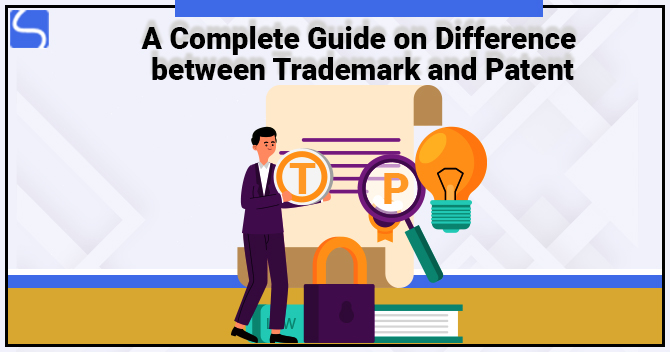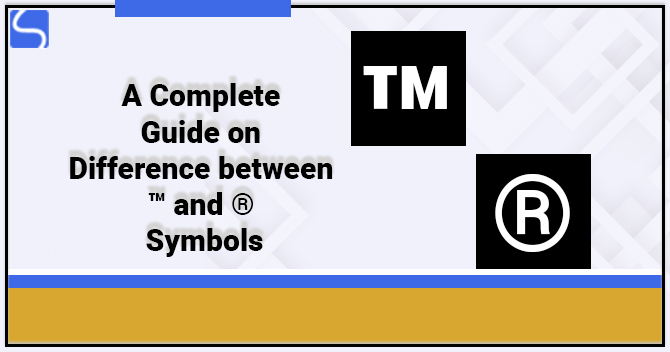Difference between Trademark and Patent: A Complete Guide

Karan Singh | Updated: Mar 20, 2021 | Category: Patent, Trademark
In today’s era, the world we live in is ambitious by innovation, and numerous Research and Development (R&D) projects are going worldwide. As per the KPMG Survey in 2018, India is the third-largest tech innovation country in the globe. This grants a reality regarding the meaning of IP (Intellectual Property) and its contribution to the growth and promotion of innovation & research projects worldwide.
In recent years, IP laws have been the fastest-growing legal field. It is obvious that without having any assurance regarding the safety of innovation, creative works or a brand, it is improbable that companies or individual will be eager to give their time, money and determination to such projects.
Hence, strong IP Laws and growth in innovation work in tandem. The domain of intellectual property is massive, but it is essential to have a good understanding of the common rights that are provided through Intellectual Property, and the most commonly applied IP rights are Trademark, Copyright, and Patent. It is also observed that peoples get highly confused between different types of IP Rights. In this blog, we will only discuss the difference between Trademark and Patent.
Table of Contents
What is Trademark Registration? – An Overview
Before we discuss the difference between Trademark and Patent, let us first know the meaning of the Trademark. A Trademark is a logo, symbol, phrase, or word that differentiates a company’s products from any other company in the market. It should be unique, different, and capable of being represented graphically. It can also differentiate the products or services of one individual from others whose brand can be already registered under the Trademark Law.
Trademark Registration safeguards and assists in brand creation which is extremely vital to the growth of a company. The first and foremost thing that a customer recognizes is the brand through its unique and distinct name. Hence, keeping the uniqueness and selectiveness of a name secured is the main purpose of a company, which is exactly what a Trademark Registration does. Trademark Registration protects the owners of the brand from unfair competitors, such as copying and misusing the brand names or logos in the market. Thus, it inspires fair competition and makes it simple for the customer to recognize the best products or services from a specific company or a brand.
This registration gives an exclusive right to the owner of a trademark that is registered to prevent their Trademark from all other unauthorized parties from using the Trademark without any permission. This holds factual when both are dealing with the same goods and services, and there is a possibility that such use would result in a possibility of confusion. The Trademark Registration also gives an authority to the owner to permit the 3rd party to use the same in return for a payment.
What is Patent Registration? – An Overview
A Patent is one of the essential Intellectual Property Rights that act as an incentive for people to invest. They not only help the inventor to make money bust also the nation in which the patented invention is made. Basically, it gives an inventor a control grant through which the inventor observes and controls the availability of the invention to the general public. Being a part of Intellectual Property Right can be sold, licensed, inherited, assigned, or gifted.
An invention needs to be non-obvious, distinct, and unique, and most essentially, it requires to have some sort of utility. It cannot be an idea or a simple model. The owner of a Patent holds a special right for twenty years from the date of Patent Registration, Unlike Copyright, the registration is mandatory, and without it, no Intellectual Property Rights can be claimed unless it proves as a former art and claim IP rights through passing off.
The inventor is the Patent’s owner but not when it is made at the time of his employment as part of their job. Then, the employee or the organization in which the individual is working becomes the original inventor. After knowing the term Trademark and Patent, now we can move forward and discuss the difference between Trademark and Patent.
Key Difference between Trademark and Patent
You can check the difference between Trademark and Patent from the table mentioned below:
| Points | Trademark | Patent |
| Governed Under | The Trade Marks Act, 1999. | The Patents Act, 1970. |
| Types of Works and Protection | Protection of distinct and unique name that makes a brand very different from others in the marketplace. The works can include the name, logo, colour, phrase, shapes, slogans, etc. | Protections of inventions that are unique, original, and capable of being used in the industry. |
| Range and Validity | Trademark is territorial in nature to claim IP Rights should be applied to each nation separately. The validity of a registered Trademark is for ten years, and it can be renewed every ten years. | A Patent is also a territorial right, and it is effective only within a particular country. For separate patents, the applicant required to file for Patent separately for each country where Patent Protection is required. The validity of Patent is for 20 years from the date of first registration. |
| Safeguards | It safeguards the branding under which the goods or services are sold. | It safeguards inventions that are useful for the world and for the industry. For example, new invention in pharmaceutical or medical industry. |
| Provisional Application Requirement | It does not contain any provisional application, but it requires a Trademark Search. | A provisional application required to file before 12 months and a significance date claim. |
| Symbolic Representation | TM Symbol is used when the Trademark Registration is in process. ® symbol is used when registration is completed. | No symbolic representation to show the Copyright Registration. |
Conclusion
After discussing the difference between Trademark and Patent, you cannot get confused to choose the IP rights as per your requirements. Almost every business in India touches on Intellectual Property Rights and needs its protection as is protects the valuable assets of a business or company. Trademark and Patent not only prevent the rights, but they also prove as an encouragement for better creative expression and are a major incentive fort encouraging people to invest in R&D of projects globally.
Also, Read: What is the Meaning of Evergreening of Patent? – An Overview














